RustyShackleford
Hazard to Others
  
Posts: 195
Registered: 10-12-2020
Location: Northern Europe
Member Is Offline
|
|
Extraction and purification of cobalt chloride from Li-ion batteries (18650)
Unfortunately i do not have pictures of the start of the process anymore, but this video covers it: https://www.youtube.com/watch?v=OsptMfmXZic
-an arbitrary number of 18650 batteries were opened up carefully with pliers, keeping a bucket of water nearby incase one started self-heating.
-The roll of foil was spread out on a large piece of paper, and all black solid was scraped off with a plastic knife and collected into a beaker, this
is LiCoO2 along with some graphite and other trace metals.
The black solid was dissolved with HCl, this foams and releases chlorine
2LiCoO2 + 8HCl → 2LiCl + 2CoCl2 + 4H2O + Cl2
Heating and stirring should be used to minimize the time and amount of HCl needed.
The blue liquid was filtered
-Aluminium foil was added to precipitate the Co, trace Cu + Ni + other junk metals. Solution was kept warm by regular addition of foil.
-Solution was regularly tested by placing a drop of solution onto foil and heating it from below with a lighter, if there was reaction aluminium foil
addition was continued.
-After precipitating all metals, the liquid was poured off and metal powder washed with warm water multiple times. After thorough washing, warm 5%
NaOH was added to react with residual aluminium, after there was nolonger any bubbling the solution was filtered, washed and metal powder collected.
Metal powder was dissolved by warm HCl and keeping a chlorine atmosphere in the flask.
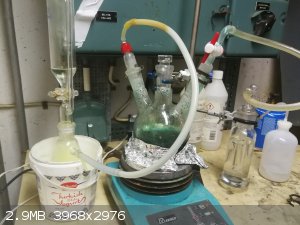
After the chlorine stopped being absorbed by the solution, solution was filtered and boiled dry. The salt at this point is quite ugly and not the
color of pure CoCl2.
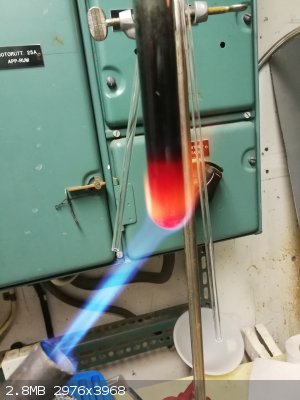
The salt is placed into a test tube, melted and heated untill red hot and kept so for a few minutes. This precipitates contaminant metal crap and
decomposes CoCl3 to CoCl2 if it didn't while boiling dry.
Solution is filtered and evaporated dry, yielding decent quality CoCl2.
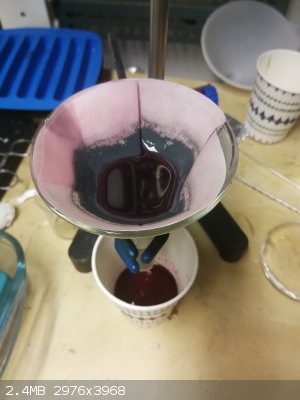
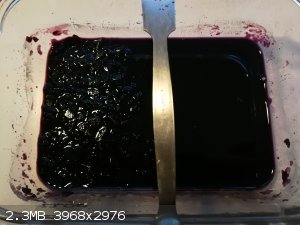
I do not have the exact numbers, but i believe i got ~55g of CoCl2 hexahydrate from around 8-10 18650 i collected from an old laptop battery.
[Edited on 28-12-2020 by RustyShackleford]
|
|
|
vano
National Hazard
   
Posts: 661
Registered: 22-3-2019
Location: Georgia
Member Is Offline
|
|
How do you separate cobalt and copper?
|
|
|
valeg96
Hazard to Others
  
Posts: 253
Registered: 6-4-2014
Location: Italy
Member Is Offline
Mood: Moodless
|
|
I extracted Co years ago by dissolving everything in acid and then precipitating the carbonates multiple times. I suggest you titrate your product
(EDTA + xylenol orange) to estimate the Co %. In my case, what I had obtained was around 50% Co(NO3)2, the rest probably NaNO3. The project was
dropped when I had enough of it (around 19 titrations later) and I just decided to buy 1 kg of CoCl2 hexahydrate from Alibaba. The chloride is
probably the most hygroscopic of the common Co salts, so you may want to consider making the carbonate (has to be dried very well to prevent
decomposition to Co3O4, though).
|
|
|
RustyShackleford
Hazard to Others
  
Posts: 195
Registered: 10-12-2020
Location: Northern Europe
Member Is Offline
|
|
If you are careful about scraping off the black solid and dont include any of the copper foil, you really shouldnt have considerable copper
contamination. but i believe you could separate it by oxalate or sulfide. Or perhaps incomplete addition of the aluminium at the beginning.
|
|
|
RustyShackleford
Hazard to Others
  
Posts: 195
Registered: 10-12-2020
Location: Northern Europe
Member Is Offline
|
|
Quote: Originally posted by valeg96  | | I extracted Co years ago by dissolving everything in acid and then precipitating the carbonates multiple times. I suggest you titrate your product
(EDTA + xylenol orange) to estimate the Co %. In my case, what I had obtained was around 50% Co(NO3)2, the rest probably NaNO3. The project was
dropped when I had enough of it (around 19 titrations later) and I just decided to buy 1 kg of CoCl2 hexahydrate from Alibaba. The chloride is
probably the most hygroscopic of the common Co salts, so you may want to consider making the carbonate (has to be dried very well to prevent
decomposition to Co3O4, though). |
Yeah in my opinion its a real PITA to make yourself, better bought than made. but i decided to post this since i had done it, if for some reason
someone wants to do it too. I cant titrate (no indicator) it but im sure its not 50% lol. Ive used it for several complexes and inorganic stuff
without issues.
|
|
|
vano
National Hazard
   
Posts: 661
Registered: 22-3-2019
Location: Georgia
Member Is Offline
|
|
Quote: Originally posted by RustyShackleford  |
If you are careful about scraping off the black solid and dont include any of the copper foil, you really shouldnt have considerable copper
contamination. but i believe you could separate it by oxalate or sulfide. Or perhaps incomplete addition of the aluminium at the beginning.
|
Thanks! I tried it a few years ago, then I was a kid and I did not know chemistry well either. But I remember it was contaminated with copper, too. I
wanted to take cobalt powder, but it was not pure, so I threw it away. I'm going to try these days. How many batteries did you used?
[Edited on 28-12-2020 by vano.kavt]
|
|
|
RustyShackleford
Hazard to Others
  
Posts: 195
Registered: 10-12-2020
Location: Northern Europe
Member Is Offline
|
|
8-10 i believe.
|
|
|
j_sum1
Administrator
       
Posts: 6218
Registered: 4-10-2014
Location: Unmoved
Member Is Offline
Mood: Organised
|
|
Interesting.
I am about to embark on a similar project myself. Extractions and Ire has a good 2 part video on it.
I intend to use ammonium oxalate to precipitate cobalt oxalate snd then ammonium carbonate to drop out the lithium.
I have all tge CoCl2 I could need and also plenty of Li metal. So this is mostly for interest. It is similar to the commercial recycling orkcess
according to Wikipedia.
|
|
|
vano
National Hazard
   
Posts: 661
Registered: 22-3-2019
Location: Georgia
Member Is Offline
|
|
You have used quite a lot of batteries. Was it all charged? When I used them, they were seated and I could not separate black powder from the copper
foil. I have not seen cobalt compounds in a long time.No one buys similar compounds here except me and it is very difficult to find a specific
compound in warehouses, because there are too many compounds. I have to believe whatever I see. That's why I'm worth trying
|
|
|
valeg96
Hazard to Others
  
Posts: 253
Registered: 6-4-2014
Location: Italy
Member Is Offline
Mood: Moodless
|
|
If you have a burette and work with metals often, I suggest you get EDTA-2Na, xylenol orange and eriochrome black T (EBT). with 1g of indicator you
can carry out probably hundreds of titrations and the pair EDTA/EBT and EDTA/Xylenol orange can be used to virtually titrate most metals around.
Xylenol orange seems to be the cheapest way to determine cobalt as well; specific indicators are much more expensive, like murexide.
I'm not a fan of titrations myself but those are very, very simple to carry out.
[Edited on 28-12-2020 by valeg96]
|
|
|
RustyShackleford
Hazard to Others
  
Posts: 195
Registered: 10-12-2020
Location: Northern Europe
Member Is Offline
|
|
Quote: Originally posted by vano.kavt  |
You have used quite a lot of batteries. Was it all charged? When I used them, they were seated and I could not separate black powder from the copper
foil. I have not seen cobalt compounds in a long time.No one buys similar compounds here except me and it is very difficult to find a specific
compound in warehouses, because there are too many compounds. I have to believe whatever I see. That's why I'm worth trying |
The batteries i used were several years old and all had quite low voltage, i didnt try calculating how discharged they were but probably less than
10%. For me the black stuff came off pretty easy, but maybe if it doesnt you could use a knife of stiff brush, perhaps boil the foil in water for a
while to try to loosen it up.
[Edited on 28-12-2020 by RustyShackleford]
|
|
|
vano
National Hazard
   
Posts: 661
Registered: 22-3-2019
Location: Georgia
Member Is Offline
|
|
I carefully separated the black powder from the copper and added hydrochloric acid. I filtered the solution and added different salts to test it,
though all were blue in color. I made selenite. It has a light blue color. I have copper selenite and it has a different color (dark blue). As a rule
this salt of cobalt should be pink. I do not understand why chloride has a blue color in the solution.
|
|
|
valeg96
Hazard to Others
  
Posts: 253
Registered: 6-4-2014
Location: Italy
Member Is Offline
Mood: Moodless
|
|
Cobalt in aqueous solution follows the generic equilibrium
[Co(H2O)6]2+(aq)(pink) + 4 Cl-(aq) ⇌ [CoCl4]2-(aq)(blue) + 6 H2O
If your solution had excess HCl, it's normal for it to be blue. If you dissolve clean, pure CoCl2 in water, it is pink. Plenty of Co(II)
compounds, with the right ligands or anions, are blue. If you take CoCl2 hexahydrate and heat it to remove the water of crystallization, it
will turn blue.
This is basically the same thing that happens when you dissolve CuCl2 tetrahydrate in water (green) and add HCl (yellow). The equilibrium
shifts towards the yellow [CuCl4]2- anion. With copper, though, making yellow salts and complexes is a bit harder, but possible.
https://edu.rsc.org/experiments/the-equilibrium-between-two-...
[Edited on 28-12-2020 by valeg96]
[Edited on 28-12-2020 by valeg96]
[Edited on 28-12-2020 by valeg96]
[Edited on 28-12-2020 by valeg96]
|
|
|
vano
National Hazard
   
Posts: 661
Registered: 22-3-2019
Location: Georgia
Member Is Offline
|
|
Thanks Valeg. I have had contact with many rare elements and substances, but unfortunately very little with cobalt. Everything is clear but I do not
understand why my selenite is blue. May be an ammonia complex. In short I do not know and I try again.
|
|
|
valeg96
Hazard to Others
  
Posts: 253
Registered: 6-4-2014
Location: Italy
Member Is Offline
Mood: Moodless
|
|
Quote: Originally posted by vano.kavt  | | Thanks Valeg. I have had contact with many rare elements and substances, but unfortunately very little with cobalt. Everything is clear but I do not
understand why my selenite is blue. May be an ammonia complex. In short I do not know and I try again. |
If you want to try again, you can follow this procedure. https://www.chempap.org/file_access.php?file=362a169.pdf
|
|
|
vano
National Hazard
   
Posts: 661
Registered: 22-3-2019
Location: Georgia
Member Is Offline
|
|
Thank you. Look at the photo I meant it. It has a very strange color. For example, in the research, unfortunately, none of the compounds have the
color blue.
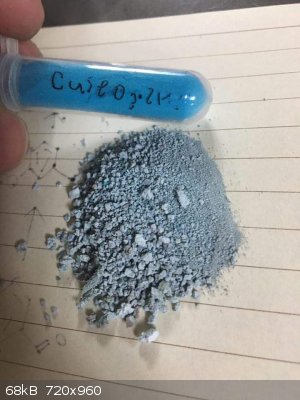
|
|
|
RustyShackleford
Hazard to Others
  
Posts: 195
Registered: 10-12-2020
Location: Northern Europe
Member Is Offline
|
|
Quote: Originally posted by vano.kavt  |
Thank you. Look at the photo I meant it. It has a very strange color. For example, in the research, unfortunately, none of the compounds have the
color blue.
|
might be due to the crap that crap that precipitates when you melt the salt to red hot.
|
|
|
Syn the Sizer
National Hazard
   
Posts: 591
Registered: 12-11-2019
Location: Canada
Member Is Offline
|
|
I am glad you shared this write here for everybody to see.
|
|
|